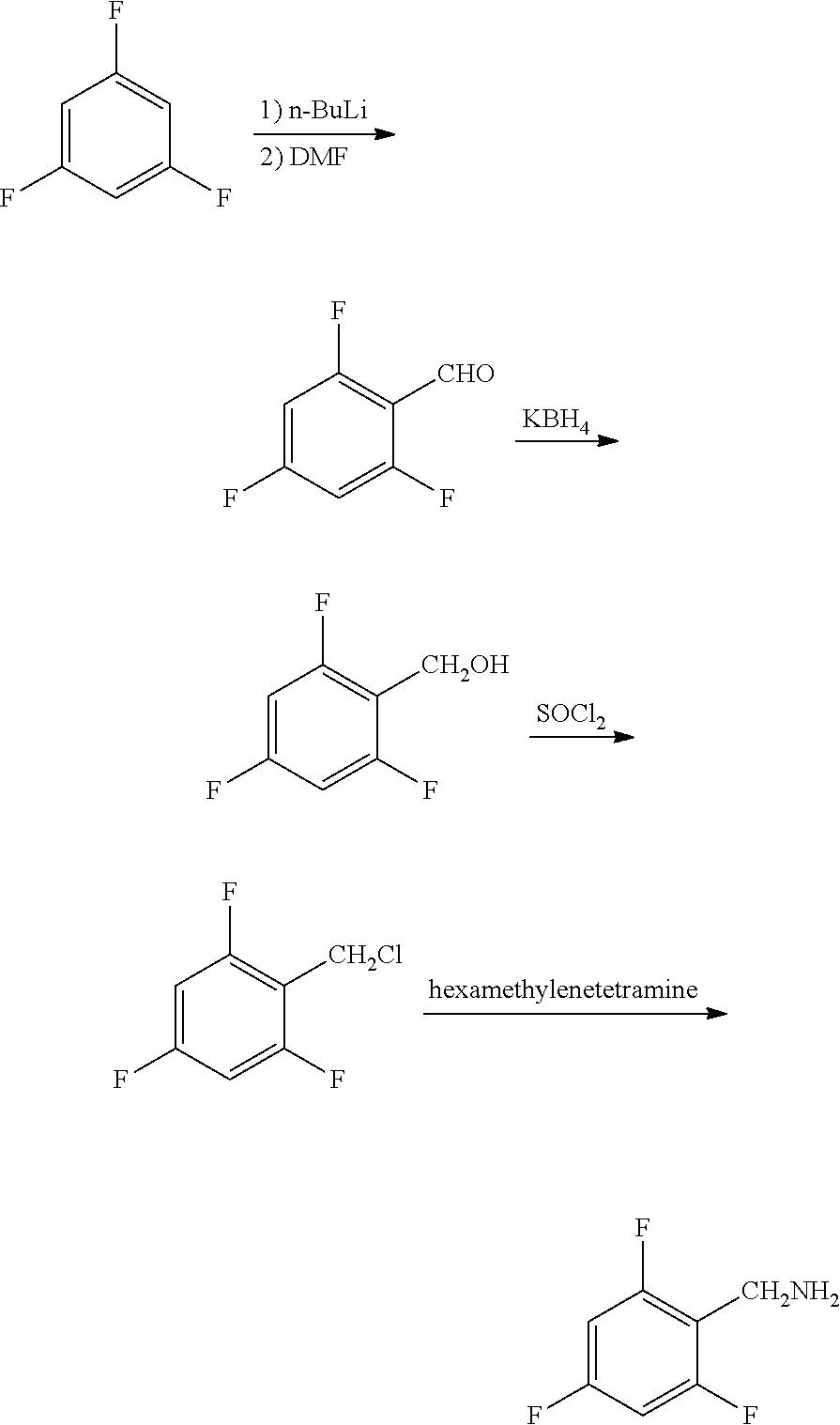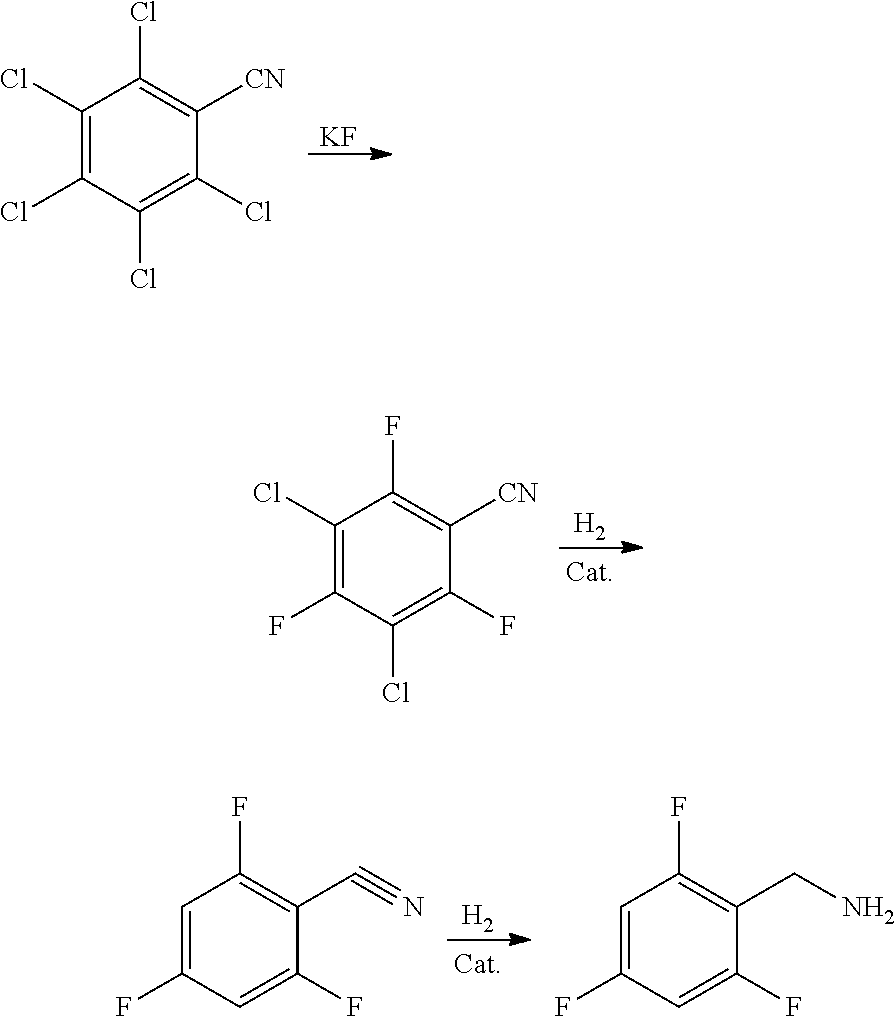Synthesis method of 2,4,6-trifluorobenzylamine
a technology of trifluorobenzonitrile and synthesis method, which is applied in the direction of physical/chemical process catalysts, organic compounds/hydrides/coordination complex catalysts, metal/metal-oxide/metal-hydroxide catalysts, etc., can solve the problems of lack of industrial application values, inability to apply synthesis methods on large scale, and high price of raw materials 2,4,6-trifluorobenzonitrile. , the effect of short reaction steps and low
- Summary
- Abstract
- Description
- Claims
- Application Information
AI Technical Summary
Benefits of technology
Problems solved by technology
Method used
Image
Examples
example 1
[0047]90 g of pentachlorobenzonitrile, 270 g of 2,4,6-trifluoro-3,5-dichlorobenzonitrile, 69 g of potassium fluoride and 9 g of cetyltrimethylammonium chloride were added into a 500 ml dry reaction bottle, stirred, heated to 180-190° C. preserved and reacted for 20 h, the reaction was stopped and cooled. When the internal temperature was dropped to less than 80° C., vacuum distillation was carried out until the system was completely evaporated to dryness, so as to obtain 342.5 g of 2,4,6-trifluoro-3,5-dichlorobenzonitrile in total. After the solvent was removed, 72.5 g of 2,4,6-trifluoro-3,5-dichlorobenzonitrile was actually obtained. The yield was 98.2% and the purity was 98.7%.
example 2
[0048]70 g of pentachlorobenzonitrile, 140 g of 2,4,6-trifluoro-3,5-dichlorobenzonitrile, 47.5 g of potassium fluoride and 14 g of tetraphenylphosphonium bromide were added into a 500 ml dry reaction bottle, stirred, heated to 200˜210° C., preserved and reacted for 24 h, the reaction was stopped and cooled. After room temperature was reached, 150 g of water was added, stirred for 30 min at room temperature, and a lower-layer organic phase, namely, 196.5 g of 2,4,6-trifluoro-3,5-dichlorobenzonitrile, was separated by standing. After the solvent was removed, 56.5 g of 2,4,6-trifluoro-3,5-dichlorobenzonitrile was actually obtained. The yield was 98.3% and the purity was 98.6%.
example 3
[0049]50 g of pentachlorobenzonitrile, 350 g of 2,4,6-trifluoro-3,5-dichlorobenzonitrile, 50 g of potassium fluoride and 7.5 g of 18-crown-6 were added into a 500 ml dry reaction bottle, stirred, heated to 170˜180° C., preserved and reacted for 16 h, the reaction was stopped and cooled. When the internal temperature was dropped to less than 80° C., vacuum distillation was carried out until the system was completely evaporated to dryness, so as to obtain 390.3 g of 2,4,6-trifluoro-3,5-dichlorobenzonitrile. After the solvent was removed, 40.3 g of 2,4,6-trifluoro-3,5-dichlorobenzonitrile was actually obtained. The yield was 98.2% and the purity was 99.3%.
PUM
| Property | Measurement | Unit |
|---|---|---|
| temperature | aaaaa | aaaaa |
| temperature | aaaaa | aaaaa |
| temperature | aaaaa | aaaaa |
Abstract
Description
Claims
Application Information
 Login to View More
Login to View More - R&D
- Intellectual Property
- Life Sciences
- Materials
- Tech Scout
- Unparalleled Data Quality
- Higher Quality Content
- 60% Fewer Hallucinations
Browse by: Latest US Patents, China's latest patents, Technical Efficacy Thesaurus, Application Domain, Technology Topic, Popular Technical Reports.
© 2025 PatSnap. All rights reserved.Legal|Privacy policy|Modern Slavery Act Transparency Statement|Sitemap|About US| Contact US: help@patsnap.com



